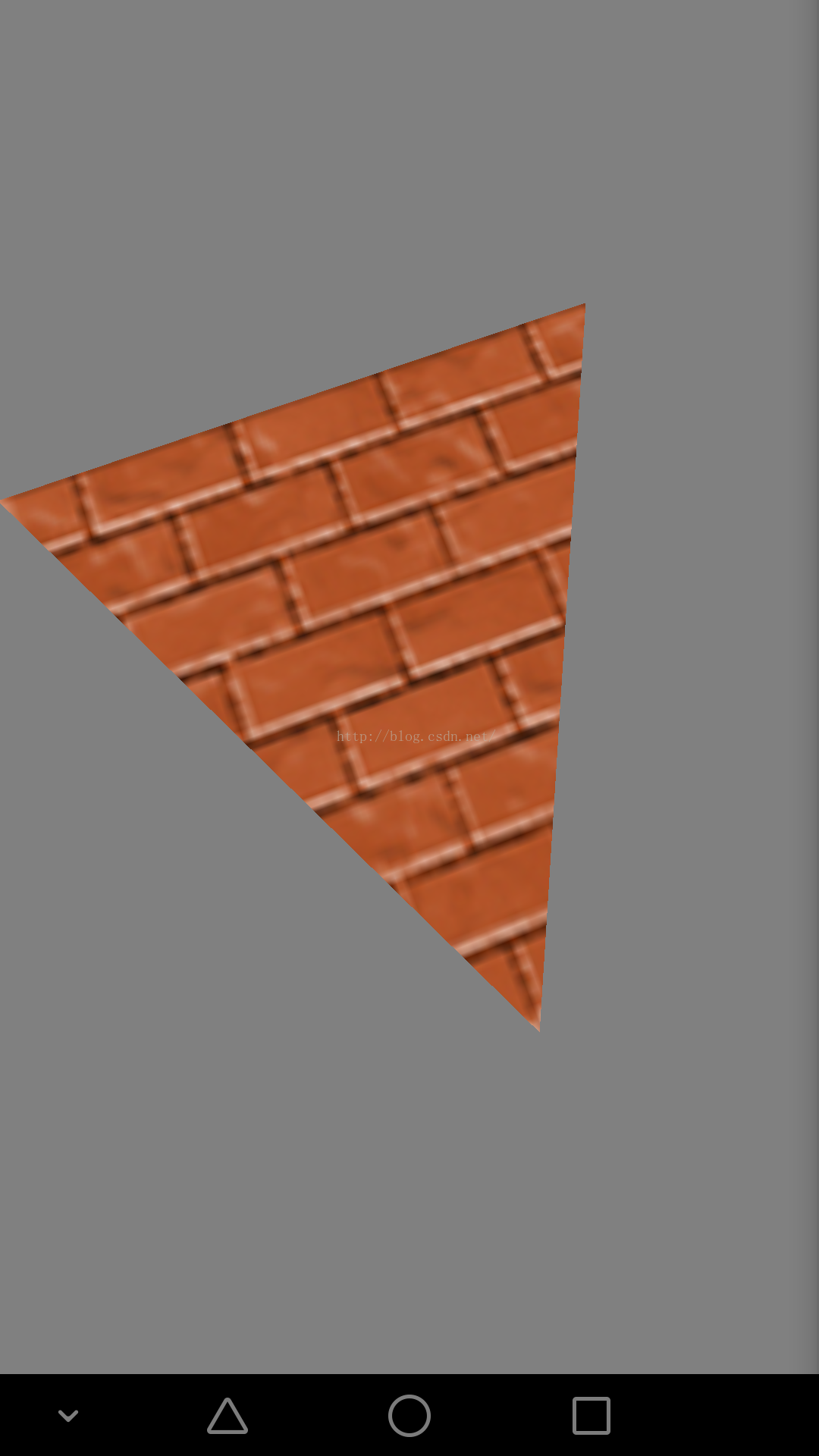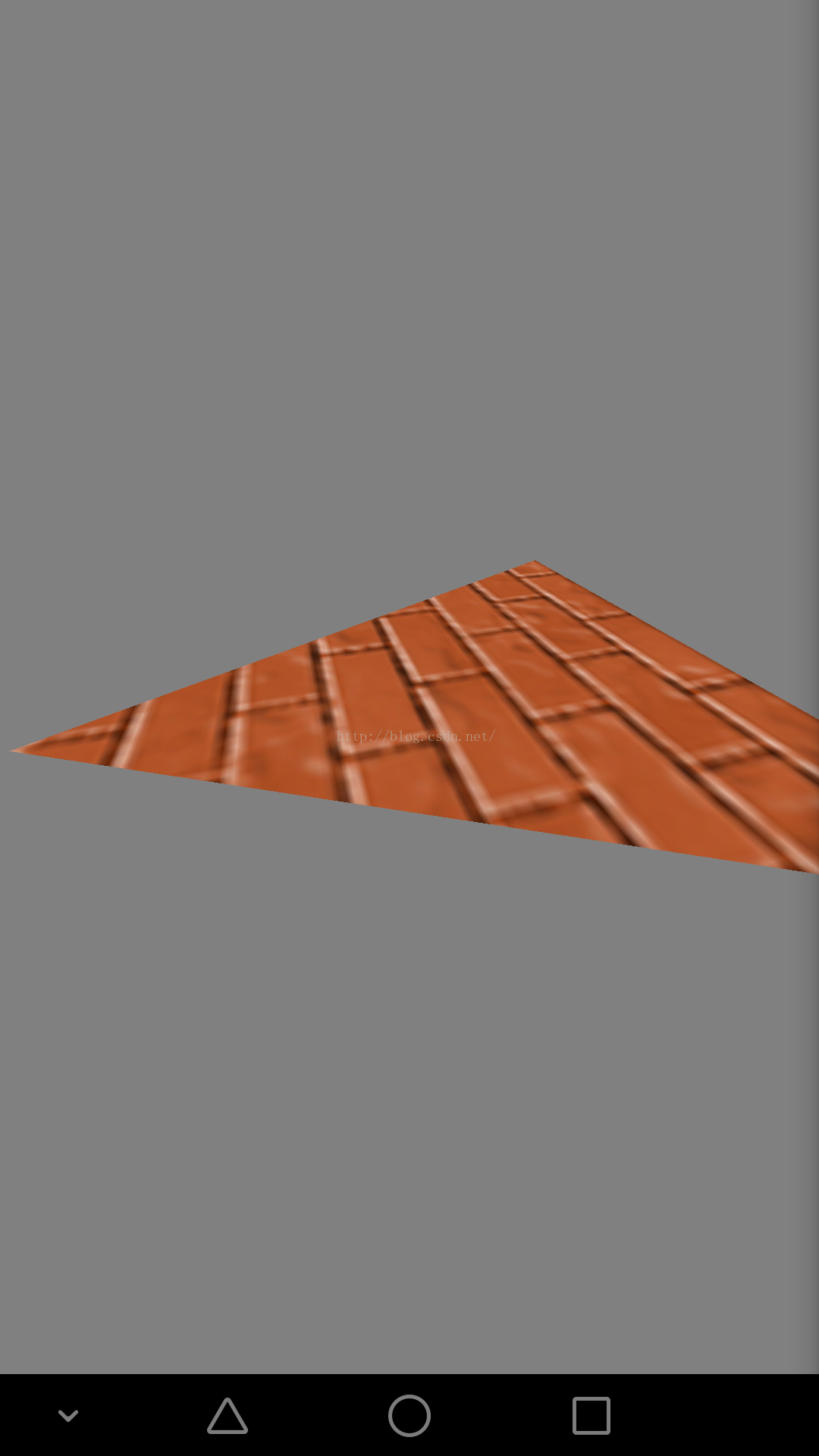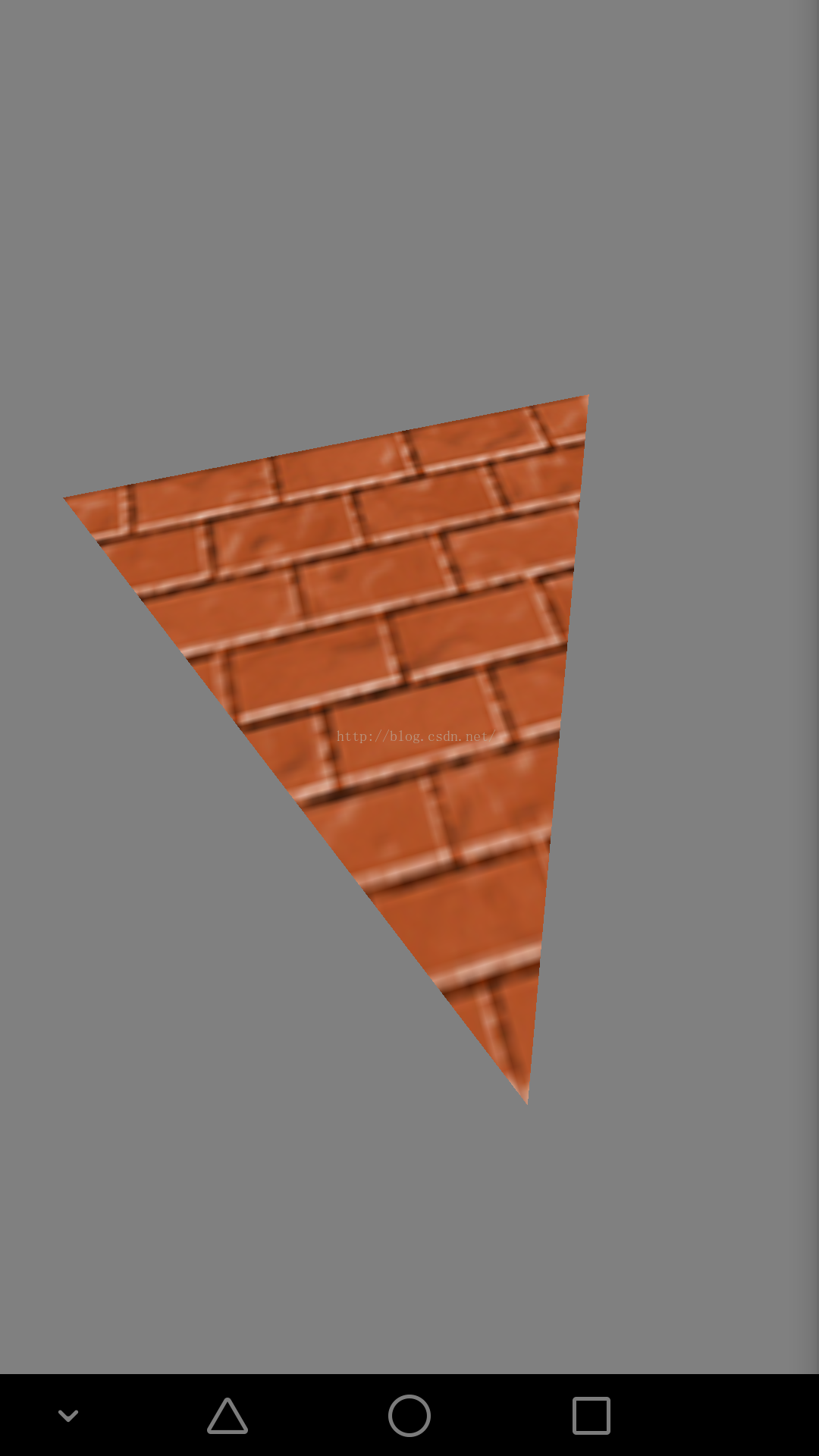編輯:關於Android編程
矩陣變換類
package test.com.opengles7_1;
import android.opengl.Matrix;
/**
* Created by hbin on 2016/8/15.
*/
public class MatrixState {
private static float[] mProjMatrix = new float[16];//4x4矩陣 投影用
private static float[] mVMatrix = new float[16];//攝像機位置朝向9參數矩陣
private static float[] mMVPMatrix;//最後起作用的總變換矩陣
static float[] mMMatrix=new float[16] ;//具體物體的移動旋轉矩陣
public static void setInitStack()//獲取不變換初始矩陣
{
Matrix.setRotateM(mMMatrix, 0, 0, 1, 0, 0);
}
public static void translate(float x,float y,float z)//設置沿xyz軸移動
{
Matrix.translateM(mMMatrix, 0, x, y, z);
}
public static void rotate(float angle,float x,float y,float z)//設置繞xyz軸轉動
{
Matrix.rotateM(mMMatrix,0,angle,x,y,z);
}
//設置攝像機
public static void setCamera
(
float cx, //攝像機位置x
float cy, //攝像機位置y
float cz, //攝像機位置z
float tx, //攝像機目標點x
float ty, //攝像機目標點y
float tz, //攝像機目標點z
float upx, //攝像機UP向量X分量
float upy, //攝像機UP向量Y分量
float upz //攝像機UP向量Z分量
)
{
Matrix.setLookAtM
(
mVMatrix,
0,
cx,
cy,
cz,
tx,
ty,
tz,
upx,
upy,
upz
);
}
//設置透視投影參數
public static void setProjectFrustum
(
float left, //near面的left
float right, //near面的right
float bottom, //near面的bottom
float top, //near面的top
float near, //near面距離
float far //far面距離
)
{
Matrix.frustumM(mProjMatrix, 0, left, right, bottom, top, near, far);
}
//獲取具體物體的總變換矩陣
public static float[] getFinalMatrix()
{
mMVPMatrix=new float[16];
Matrix.multiplyMM(mMVPMatrix, 0, mVMatrix, 0, mMMatrix, 0);
Matrix.multiplyMM(mMVPMatrix, 0, mProjMatrix, 0, mMVPMatrix, 0);
return mMVPMatrix;
}
}
三角形繪制類
package test.com.opengles7_1;
import android.opengl.GLES20;
import java.nio.ByteBuffer;
import java.nio.ByteOrder;
import java.nio.FloatBuffer;
/**
* Created by hbin on 2016/8/15.
* 紋理三角形
*/
public class Triangle {
int mProgram;//自定義渲染管線程序id
int muMVPMatrixHandle;//總變換矩陣引用id
int maPositionHandle; //頂點位置屬性引用id
int maTexCoorHandle; //頂點紋理坐標屬性引用id
String mVertexShader;//頂點著色器
String mFragmentShader;//片元著色器
FloatBuffer mVertexBuffer;//頂點坐標數據緩沖
FloatBuffer mTexCoorBuffer;//頂點紋理坐標數據緩沖
int vCount=0;
float xAngle=0;//繞x軸旋轉的角度
float yAngle=0;//繞y軸旋轉的角度
float zAngle=0;//繞z軸旋轉的角度
public Triangle(MySurfaceView mv)
{
//初始化頂點坐標與著色數據
initVertexData();
//初始化著色器
initShader(mv);
}
//初始化頂點坐標與著色數據的方法
public void initVertexData()
{
vCount=3;
final float UNIT_SIZE=0.15F;
float vertices[]=new float[]
{
0*UNIT_SIZE,11*UNIT_SIZE,0,
-11*UNIT_SIZE,-11*UNIT_SIZE,0,
11*UNIT_SIZE,-11*UNIT_SIZE,0
};
//創建頂點坐標數據緩沖
ByteBuffer vbb=ByteBuffer.allocateDirect(vertices.length*4);
vbb.order(ByteOrder.nativeOrder());//設置字節順序
mVertexBuffer=vbb.asFloatBuffer();
mVertexBuffer.put(vertices);//向緩沖區放入頂點坐標數據
mVertexBuffer.position(0);//設置緩沖區起始位置
//頂點紋理坐標數據的初始化
float texCoor[]=new float[]//頂點顏色值數組,每個頂點4個色彩值RGBA
{
0.5f,0,
0,1,
1,1
};
//創建頂點紋理坐標數據緩沖
ByteBuffer cbb=ByteBuffer.allocateDirect(texCoor.length*4);
cbb.order(ByteOrder.nativeOrder());
mTexCoorBuffer=cbb.asFloatBuffer();
mTexCoorBuffer.put(texCoor);
mTexCoorBuffer.position(0);
}
//初始化著色器
public void initShader(MySurfaceView mv)
{
//加載頂點著色器的腳本內容
mVertexShader=ShaderUtil.loadFromAssetsFile("vertex.sh", mv.getResources());
//加載片元著色器的腳本內容
mFragmentShader=ShaderUtil.loadFromAssetsFile("frag.sh", mv.getResources());
//基於頂點著色器與片元著色器創建程序
mProgram = ShaderUtil.createProgram(mVertexShader, mFragmentShader);
//獲取程序中頂點位置屬性引用id
maPositionHandle = GLES20.glGetAttribLocation(mProgram, "aPosition");
//獲取程序中頂點紋理坐標屬性引用id
maTexCoorHandle= GLES20.glGetAttribLocation(mProgram, "aTexCoor");
//獲取程序中總變換矩陣引用id
muMVPMatrixHandle = GLES20.glGetUniformLocation(mProgram, "uMVPMatrix");
}
public void drawSelf(int texId)
{
//制定使用某套shader程序
GLES20.glUseProgram(mProgram);
MatrixState.setInitStack();
//設置沿Z軸正向位移1
MatrixState.translate(0,0,1);
//設置繞y軸旋轉
MatrixState.rotate(yAngle,0,1,0);
//設置繞Z軸旋轉
MatrixState.rotate(zAngle,0,0,1);
//設置繞x軸旋轉
MatrixState.rotate(xAngle,1,0,0);
//將最終變換矩陣傳入shader程序
GLES20.glUniformMatrix4fv(muMVPMatrixHandle,1,false,MatrixState.getFinalMatrix(),0);
//為畫筆指定頂點位置數據
GLES20.glVertexAttribPointer(
maPositionHandle,
3,
GLES20.GL_FLOAT,
false,
3*4,
mVertexBuffer
);
//為畫筆指定頂點紋理坐標數據
GLES20.glVertexAttribPointer(
maTexCoorHandle,
2,
GLES20.GL_FLOAT,
false,
2*4,
mTexCoorBuffer
);
//允許頂點位置數據數組
GLES20.glEnableVertexAttribArray(maPositionHandle);
GLES20.glEnableVertexAttribArray(maTexCoorHandle);
//綁定紋理
GLES20.glActiveTexture(GLES20.GL_TEXTURE0);
GLES20.glBindTexture(GLES20.GL_TEXTURE_2D, texId);
//繪制紋理矩形
GLES20.glDrawArrays(GLES20.GL_TRIANGLES, 0, vCount);
}
}
package test.com.opengles7_1;
import android.content.Context;
import android.content.res.AssetManager;
import android.content.res.Resources;
import android.graphics.Bitmap;
import android.graphics.BitmapFactory;
import android.opengl.GLES20;
import android.opengl.GLSurfaceView;
import android.opengl.GLUtils;
import android.view.MotionEvent;
import java.io.IOException;
import java.io.InputStream;
import javax.microedition.khronos.egl.EGLConfig;
import javax.microedition.khronos.opengles.GL10;
/**
* Created by hbin on 2016/8/15.
*/
public class MySurfaceView extends GLSurfaceView {
private final float TOUCH_SCALE_FACTOR=180.0f/320;//角度縮放比例
private SceneRenderer mRenderer;//場景渲染器
private float mPreviousY;//上次的觸控位置Y坐標
private float mPreviousX;//上次的觸控位置X坐標
int textureId;//系統分配的紋理id
public MySurfaceView(Context context) {
super(context);
this.setEGLContextClientVersion(2);
mRenderer=new SceneRenderer();
setRenderer(mRenderer);
setRenderMode(GLSurfaceView.RENDERMODE_CONTINUOUSLY);
}
@Override
public boolean onTouchEvent(MotionEvent e){
float y=e.getY();
float x=e.getX();
switch (e.getAction()){
case MotionEvent.ACTION_MOVE:
float dy=y-mPreviousY;
float dx=x-mPreviousX;
mRenderer.texRect.yAngle+=dx*TOUCH_SCALE_FACTOR;
mRenderer.texRect.zAngle+=dy*TOUCH_SCALE_FACTOR;
}
mPreviousY=y;
mPreviousX=x;
return true;
}
private class SceneRenderer implements GLSurfaceView.Renderer{
Triangle texRect;//紋理矩形
@Override
public void onSurfaceCreated(GL10 gl, EGLConfig config) {
//設置屏幕背景色
GLES20.glClearColor(0.5f,0.5f,0.5f,1.0f);
texRect=new Triangle(MySurfaceView.this);
GLES20.glEnable(GLES20.GL_DEPTH_TEST);
initTexture();
//關閉背面剪裁
GLES20.glDisable(GLES20.GL_CULL_FACE);
}
@Override
public void onSurfaceChanged(GL10 gl, int width, int height) {
//設置視窗大小及位置
GLES20.glViewport(0,0,width,height);
//計算寬高比
float ratio=(float)width/height;
//生成透視投影矩陣
MatrixState.setProjectFrustum(-ratio,ratio,-1,1,1,10);
//生成攝像機9參數位置矩陣
MatrixState.setCamera(0,0,3,0f,0f,0f,0f,1.0f,0f);
}
@Override
public void onDrawFrame(GL10 gl) {
//清除深度緩沖與顏色緩沖
GLES20.glClear(GLES20.GL_DEPTH_BUFFER_BIT | GLES20.GL_COLOR_BUFFER_BIT);
//繪制紋理矩形
texRect.drawSelf(textureId);
}
}
public void initTexture()//textureId
{
//生成紋理id
int[] textures=new int[1];
GLES20.glGenTextures
(
1,//產生的紋理id數量
textures,//紋理id的數組
0 //偏移量
);
textureId=textures[0];
GLES20.glBindTexture(GLES20.GL_TEXTURE_2D,textureId);
GLES20.glTexParameterf(GLES20.GL_TEXTURE_2D, GLES20.GL_TEXTURE_MIN_FILTER,
GLES20.GL_NEAREST);
GLES20.glTexParameterf(GLES20.GL_TEXTURE_2D,GLES20.GL_TEXTURE_MAG_FILTER,
GLES20.GL_LINEAR);
GLES20.glTexParameterf(GLES20.GL_TEXTURE_2D,GLES20.GL_TEXTURE_WRAP_S,
GLES20.GL_CLAMP_TO_EDGE);
GLES20.glTexParameterf(GLES20.GL_TEXTURE_2D,GLES20.GL_TEXTURE_WRAP_T,
GLES20.GL_CLAMP_TO_EDGE);
//通過輸入流加載圖片
AssetManager am=getResources().getAssets();
InputStream is=null;;
Bitmap bitmap=null;
try {
// is=am.open("wall.png");
Resources res=this.getContext().getResources();
is=res.openRawResource(R.raw.wall);
bitmap= BitmapFactory.decodeStream(is);
}catch (Exception ex){
ex.printStackTrace();
}
finally {
try {
is.close();
}catch (Exception ex){
ex.printStackTrace();
}
}
//實際加載紋理
GLUtils.texImage2D
(
GLES20.GL_TEXTURE_2D,//紋理類型,在OpenGL ES中必須為GL10.GL_TEXTURE_2D
0,//紋理的層次,0表示基本圖像層,可以理解為直接貼圖
bitmap,//紋理圖像
0 //紋理邊框尺寸
);
bitmap.recycle(); //紋理加載成功後釋放圖片
}
}
package test.com.opengles7_1;
import android.content.res.Resources;
import android.opengl.GLES20;
import android.util.Log;
import java.io.ByteArrayOutputStream;
import java.io.InputStream;
/**
* Created by hbin on 2016/8/15.
* 加載頂點Shader與片元Shader的工具類
*/
public class ShaderUtil {
//加載制定shader的方法
public static int loadShader
(
int shaderType, //shader的類型 GLES20.GL_VERTEX_SHADER GLES20.GL_FRAGMENT_SHADER
String source //shader的腳本字符串
)
{
//創建一個新shader
int shader = GLES20.glCreateShader(shaderType);
//若創建成功則加載shader
if (shader != 0)
{
//加載shader的源代碼
GLES20.glShaderSource(shader, source);
//編譯shader
GLES20.glCompileShader(shader);
//存放編譯成功shader數量的數組
int[] compiled = new int[1];
//獲取Shader的編譯情況
GLES20.glGetShaderiv(shader, GLES20.GL_COMPILE_STATUS, compiled, 0);
if (compiled[0] == 0)
{//若編譯失敗則顯示錯誤日志並刪除此shader
Log.e("ES20_ERROR", "Could not compile shader " + shaderType + ":");
Log.e("ES20_ERROR", GLES20.glGetShaderInfoLog(shader));
GLES20.glDeleteShader(shader);
shader = 0;
}
}
return shader;
}
//創建shader程序的方法
public static int createProgram(String vertexSource, String fragmentSource)
{
//加載頂點著色器
int vertexShader = loadShader(GLES20.GL_VERTEX_SHADER, vertexSource);
if (vertexShader == 0)
{
return 0;
}
//加載片元著色器
int pixelShader = loadShader(GLES20.GL_FRAGMENT_SHADER, fragmentSource);
if (pixelShader == 0)
{
return 0;
}
//創建程序
int program = GLES20.glCreateProgram();
//若程序創建成功則向程序中加入頂點著色器與片元著色器
if (program != 0)
{
//向程序中加入頂點著色器
GLES20.glAttachShader(program, vertexShader);
checkGlError("glAttachShader");
//向程序中加入片元著色器
GLES20.glAttachShader(program, pixelShader);
checkGlError("glAttachShader");
//鏈接程序
GLES20.glLinkProgram(program);
//存放鏈接成功program數量的數組
int[] linkStatus = new int[1];
//獲取program的鏈接情況
GLES20.glGetProgramiv(program, GLES20.GL_LINK_STATUS, linkStatus, 0);
//若鏈接失敗則報錯並刪除程序
if (linkStatus[0] != GLES20.GL_TRUE)
{
Log.e("ES20_ERROR", "Could not link program: ");
Log.e("ES20_ERROR", GLES20.glGetProgramInfoLog(program));
GLES20.glDeleteProgram(program);
program = 0;
}
}
return program;
}
//檢查每一步操作是否有錯誤的方法
public static void checkGlError(String op)
{
int error;
while ((error = GLES20.glGetError()) != GLES20.GL_NO_ERROR)
{
Log.e("ES20_ERROR", op + ": glError " + error);
throw new RuntimeException(op + ": glError " + error);
}
}
//從sh腳本中加載shader內容的方法
public static String loadFromAssetsFile(String fname,Resources r)
{
String result=null;
try
{
InputStream in=r.getAssets().open(fname);
int ch=0;
ByteArrayOutputStream baos = new ByteArrayOutputStream();
while((ch=in.read())!=-1)
{
baos.write(ch);
}
byte[] buff=baos.toByteArray();
baos.close();
in.close();
result=new String(buff,"UTF-8");
result=result.replaceAll("\\r\\n","\n");
}
catch(Exception e)
{
e.printStackTrace();
}
return result;
}
}
效果圖



 Android登陸界面實現-支持輸入框清楚和震動效果功能
Android登陸界面實現-支持輸入框清楚和震動效果功能
演示效果主要代碼如下自定義的一個EditText,用於實現有文字的時候顯示可以清楚的按鈕:import android.content.Context;import an
 Android打造屬於自己的新聞平台(客戶端+服務器)
Android打造屬於自己的新聞平台(客戶端+服務器)
完全屬於自己的新聞展示平台,展示給大家,希望大家喜歡。一、新聞的數據庫的構建腳本代碼如下:(使用的mysql5.0 數據庫)SET SQL_MODE = NO_AUTO_
 Android開發之自定義CheckBox
Android開發之自定義CheckBox
要實現的效果如下考慮到關鍵是動畫效果,所以直接繼承View。不過CheckBox的超類CompoundButton實現了Checkable接口,這一點值得借鑒。下面記錄一
 android Unable toexecute dex: method ID not in [0, 0xffff]: 65536問題
android Unable toexecute dex: method ID not in [0, 0xffff]: 65536問題
作為一名Android開發者,相信你對Android方法數不能超過65K的限制應該有所耳聞,隨著應用程序功能不斷的豐富,總有一天你會遇到一個異常:Conversion t